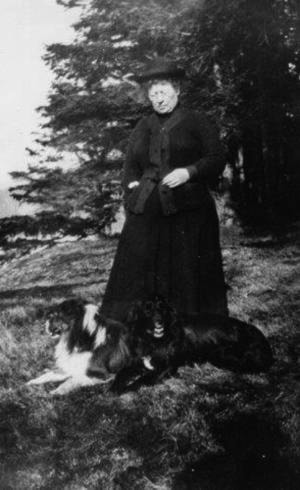Elida Peers | Contributed
Perhaps we aren’t all that far from the days of the trailblazers who hewed their way across North America.
Seen here is Mrs. Alexander Donaldson at her East Sooke home in 1912. She was the wife of the redoubtable Alexander Donaldson, born in 1839 in Scotland, who emigrated to North America and came to the west coast in 1864, by way of the Oregon Trail and a team of oxen.
Alexander Donaldson’s adventures were many; progressing northward, he freighted on the old Cariboo Road, was hired on as crew on a whaler operating in the Strait of Georgia, and prospected for copper around Sechelt. Around 1880 he was employed as a millwright at the Hastings mill in Vancouver and later at Victoria sawmills.
ALSO READ: Copper mining in East Sooke
In 1897, he married a girl who had made her own journey west from her birthplace in Petrolia, Ont., and by 1901 the couple was living at the far end of East Sooke Road, where they began raising their family.
The couple connected with Victoria by a wagon road leading through Metchosin, and to Sooke village by rowboat across the harbour to the government wharf.
The Donaldson used horses for farm work, and while versatile, the farm mainly produced sheep, and grew their own crops for feed.
The senior Donaldson continued prospecting, for copper and granite, opening the Willow Grouse Mine (now in East Sooke Park) which provided copper for use in the First World War. The granite quarry he established on Texada Island was used in the building of the Parliament Buildings in Victoria.
Son Alec Donaldson took over the farm when the elder Donaldson died in 1908. The large barns were a notable feature of the sloping farmland, rising from the water at the entrance to Sooke harbour, until a windstorm in 1956 flattened the buildings.
While none of the family live on the site today, their heritage is well recognized, with Mount Donaldson in the B.C. Interior, and Donaldson Island (commonly called Secretary Island) well known to our many fishing friends.
A historical marker has been placed at the entrance to the old farm, through the courtesy of a grandson, Eric Clay. Eric Clay’s mother, Victoria Donaldson Clay, daughter of the woman pictured, was a much appreciated contributor of knowledge to the Sooke Region Museum’s archives.
•••
Elida Peers is the historian of the Sooke Region Museum.
